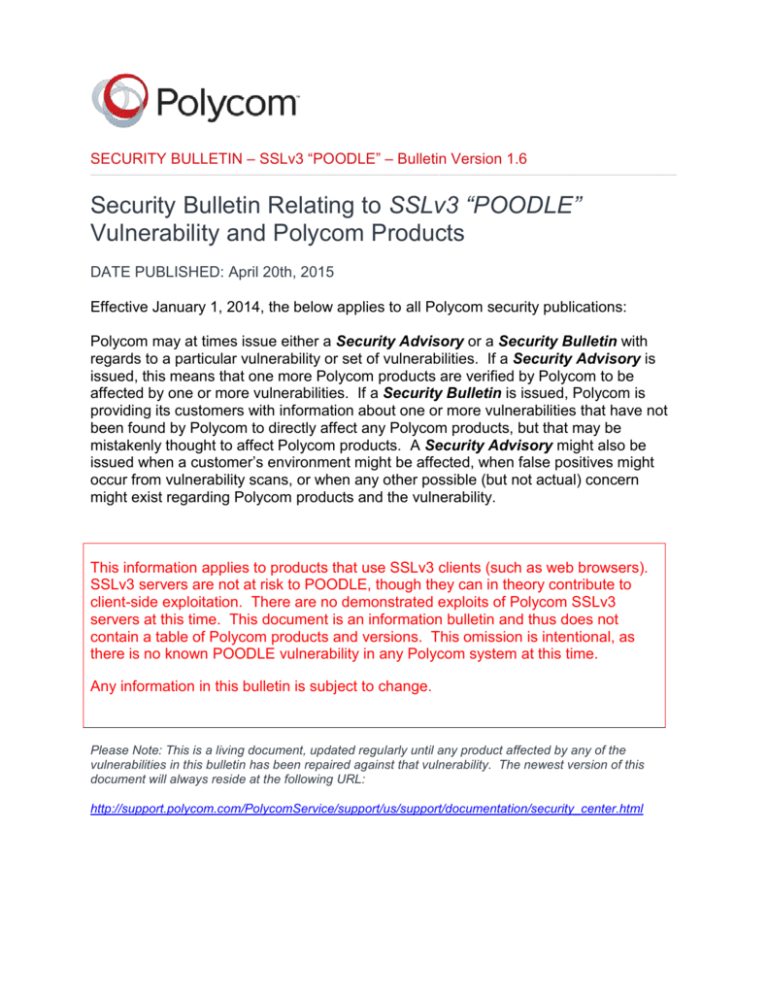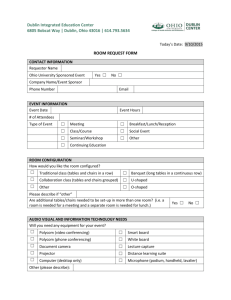
SECURITY BULLETIN – SSLv3 “POODLE” – Bulletin Version 1.6
_____________________________________________________________________________________________________________________________ _____________________________________________________________________________________
Security Bulletin Relating to SSLv3 “POODLE”
Vulnerability and Polycom Products
DATE PUBLISHED: April 20th, 2015
Effective January 1, 2014, the below applies to all Polycom security publications:
Polycom may at times issue either a Security Advisory or a Security Bulletin with
regards to a particular vulnerability or set of vulnerabilities. If a Security Advisory is
issued, this means that one more Polycom products are verified by Polycom to be
affected by one or more vulnerabilities. If a Security Bulletin is issued, Polycom is
providing its customers with information about one or more vulnerabilities that have not
been found by Polycom to directly affect any Polycom products, but that may be
mistakenly thought to affect Polycom products. A Security Advisory might also be
issued when a customer’s environment might be affected, when false positives might
occur from vulnerability scans, or when any other possible (but not actual) concern
might exist regarding Polycom products and the vulnerability.
This information applies to products that use SSLv3 clients (such as web browsers).
SSLv3 servers are not at risk to POODLE, though they can in theory contribute to
client-side exploitation. There are no demonstrated exploits of Polycom SSLv3
servers at this time. This document is an information bulletin and thus does not
contain a table of Polycom products and versions. This omission is intentional, as
there is no known POODLE vulnerability in any Polycom system at this time.
Any information in this bulletin is subject to change.
Please Note: This is a living document, updated regularly until any product affected by any of the
vulnerabilities in this bulletin has been repaired against that vulnerability. The newest version of this
document will always reside at the following URL:
http://support.polycom.com/PolycomService/support/us/support/documentation/security_center.html
SECURITY BULLETIN – SSLV3 “POODLE” - APRIL 2015 VERSION 1.6
Vulnerability Summary
A vulnerability was discovered in the SSLv3 protocol. Two systems engaged in a dialogue to determine
their mutual level of protocol support (TLS included) can often negotiate downward to the older and
obsolete SSLv3 protocol during the “handshake” if configurations allow. This vulnerability leverages this
phenomenon as well as weaknesses in the CBC padding in SSLv3 to facilitate the establishment of a
man-in-the-middle attack whose purpose is to decrypt the dialogue in order to read data in cleartext.
Vulnerability Details
CVE-2014-3566, aka “POODLE”
The SSL protocol version 3.0 (incorporated in OpenSSL through 1.0.1i, and other cryptography products)
uses nondeterministic padding for its CBC (“cipher block chaining” encryption), which makes it easier for
man-in-the-middle attackers to obtain cleartext data via a padding-oracle attack, aka the "POODLE"
issue. By combining this fact with the downward negotiation described above, a client can be
compromised by a malicious server.
“POODLE” is a client vulnerability. Servers (or products with embedded servers in them) that support
SSLv3 in theory can contribute somewhat to a client exploitation if the client is not itself properly
configured (to disable SSLv3 support) and if other network conditions and an attacker are also present.
Network conditions are listed in “Impact and Risk” below. Also please see “General Mitigations” for ways
to reduce client risk.
Impact and Risk
As of the time of this bulletin’s publication (v1.0), no known exploits of this vulnerability have been
reported.
Though this issue has received rapid attention in today’s climate (awareness in the press of security
issues has been quite high since Heartbleed), this issue is not a significant threat if the vectors and
complexity of attack are understood.
The vulnerability affects SSL clients who encounter a malicious server and who are configured to allow
support for the known-vulnerable SSLv3 protocol.
For the CBC mechanism in SSLv3 to be exploited, several factors must exist:
1. The user’s client (generally a web browser) must be set to allow SSLv3 support
2. The user must voluntarily interact with the attack mechanism via social engineering or genuine
ignorance of the threat
3. Attacker must be on the same, un-switched network as the user (this rules out nearly all
enterprise networks)
4. Attacker must then also successfully spoof a server, create a proxy, or create a conventional
man-in-the-middle server. The network environment must permit the deployment of such
illegitimate servers.
General Mitigations
Turn off your web browser’s support for SSLv3. Use only TLS v1.2 and TLS v1.1 (or TLS v1.0 if
backwards compatibility is required). This is a configurable setting in most modern browsers.
April 20th, 2015
SECURITY BULLETIN – SSLV3 “POODLE” - APRIL 2015 VERSION 1.6
Products Affected
At this point, all Polycom products that contain SSLv3 appear to support SSLv3 only on the server side.
All evidence at the time of this bulletin indicates that these products are therefore not at risk themselves.
Polycom will be removing SSLv3 support anyway per “Vulnerability Details” above to address any
concerns from analysis efforts that only look for the presence of SSLv3 and not its role in the client/server
model.
Solution
All Polycom product teams who support SSLv3 are committed to removing that support in the first half of
2015. These products use SSLv3 on the server side, so they are not in themselves vulnerable. As of the
date of this bulletin, no Polycom product has been found to be vulnerable.
CVSS v2 Base Metrics:
To assist our customers in the evaluation of this vulnerability; Polycom leverages the Common
Vulnerability Scoring System (CVSS). This system provides an open framework for communicating the
characteristics and impacts of information technology vulnerabilities that better enable our customers to
make informed decisions and assess the impact on their environment.
Base CVSS v2 Scores:
CVE-2014-3566:
4.3 (Out of 10.0) (AV:N/AC:M/Au:N/C:P/I:N/A:N)
For more information on CVSS v2 please see: http://www.first.org/cvss/cvss-guide.html
Severity: MEDIUM
Rating
Definition
Critical
A vulnerability, which, if exploited would allow malicious code to execute, potentially
without a user being aware.
High
A vulnerability, which, if exploited could impact the confidentiality, integrity, or availability of
data, or of the integrity or availability of resources.
Medium
A vulnerability that is limited to a significant degree by factors such as default configuration,
auditing, or is difficult to exploit.
Low
A vulnerability that has minimal impact to the system and is extremely difficult to exploit.
April 20th, 2015
SECURITY BULLETIN – SSLV3 “POODLE” - APRIL 2015 VERSION 1.6
Contact
Any customer using an affected system who is concerned about this vulnerability within their deployment
should contact Polycom Technical Support – either call 1-800-POLYCOM or visit:
http://support.polycom.com/PolycomService/support/us/support/documentation/security_center.html
For the latest information. You might also find value in the high-level security guidance and security news
located at:
http://www.polycom.com/security
Revision History
Revision 1.0 - Original publication: October 15, 2014
Revision 1.1 – Date commitments, clarification of vulnerability (client vs. server)
Revision 1.2 – Updated fix and commitment dates with some remediations
Revision 1.3 – Better clarity on lack of vulnerability, adjusted date for SSLv3 removal
Revision 1.4 – Updated fix and commitment dates
Revision 1.5 – Updated verbiage
Revision 1.6 – Updated dates and slight format change
©2014, Polycom, Inc. All rights reserved.
Trademarks
POLYCOM®, the Polycom logo and all names and marks associated with Polycom and Polycom's products are trademarks and/or
service marks of Polycom, Inc. and are registered and/or common law marks in the United States and various other countries. All
other trademarks are property of their respective owners. No portion hereof may be reproduced or transmitted in any form or by any
means, for any purpose other than the recipient's personal use, without the express written permission of Polycom.
Disclaimer
While Polycom uses reasonable efforts to include accurate and up-to-date information in this document, Polycom makes no
warranties or representations as to its accuracy. Polycom assumes no liability or responsibility for any typographical errors, out of
date information, or any errors or omissions in the content of this document. Polycom reserves the right to change or update this
document at any time. Individuals are solely responsible for verifying that they have and are using the most recent Technical
Bulletin.
Limitation of Liability
Polycom and/or its respective suppliers make no representations about the suitability of the information contained in this document
for any purpose. Information is provided "as is" without warranty of any kind and is subject to change without notice. The entire risk
arising out of its use remains with the recipient. In no event shall Polycom and/or its respective suppliers be liable for any direct,
consequential, incidental, special, punitive or other damages whatsoever (including without limitation, damages for loss of business
profits, business interruption, or loss of business information), even if Polycom has been advised of the possibility of such damages.
April 20th, 2015









